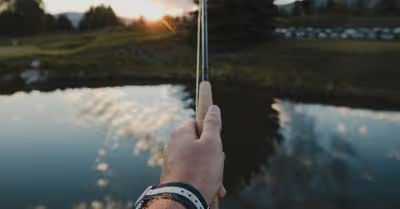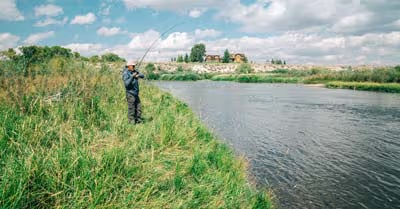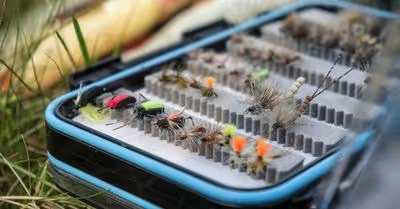Table of Contents
What Does a Jig Consist Of?
Jigs can range from fairly simple to pretty extravagant in their design. At the most basic level, a jig can be as basic as just a lead sinker and a hook. However, jigs can come in all manner of shapes, sizes, and colors, as well as feature multiple varieties of weights that can either make them heavier or lighter depending on the situation.
Commonly, jigs will have a soft plastic "bait" attached to them. These soft plastic parts are often shaped like common prey fish and will be used to lure fish to a hidden hook. This bait part of the jig can be made to come in an almost infinite array of designs depending on the type of fish you are going to be trying to catch.
When put to use, jigs are incredibly versatile and can be used to catch pretty much any type of fish that you could be going after, whether in saltwater or freshwater. As stated above, they are also the lure of choice for many ice fishermen. However, if you want to put a jig to good use, you must first understand the art of jigging itself.
What Does Jigging Entail?
Jigging is the term used to describe the action one performs with their jig lure. It generally consists of a dynamic vertical (and sometimes slightly horizontal) motion of the rod that allows the jig to dance up and down, side to side in the water. The motion of the jig, combined with the inherent attraction of the fish to the color, size, and shape of the jig, will trick any lurking fish in the water into thinking that the jig is a naturally occurring prey.
There is an intuitive element to jigging, and not one type of jigging (or jig) that works well in every situation and for every type of fish. Jigging is a fairly nuanced skill, similar to puppeteering, as the intended effect is to create the illusion of natural life. Either too much motion or not enough can totally kill the illusion for your intended prey. As well, the wrong type of motion could signal to whatever fish you are trying to catch that something unnatural is going on and they better leave before they find out what it is.
Three Common Types of Fishing Jigs
As we've discussed, there are likely as many types of jigs as there are types of fish. In fact, there may even be more types of jigs. You can even make your own jig, designed specifically to appeal to the types of fish commonly found at your favorite fishing spot.
However, there are more popular types of jigs that are well-known and common amongst most types of fishermen. Let's take a look at a handful of the most common jig types. As well, let's look at what situations these jigs might prove themselves most useful in.
Tied-Dressing Jigs
These are jigs that feature designs based around some type of "hair" material protruding from the head of the lure. This material can be made to resemble many types of underwater prey, from insects to crawfish. Due to the wide range of sizes fish can come in, these jigs can come in a wide variety of weights,
Tied-dressing jigs will also typically feature what is known as a "weed guard", as well as an internalized rattle. The weed guard is simply a few strands of material that help keep the jig from getting entangled in the weeds along the bottom of whatever body of water you are fishing in. The rattle feature is common amongst jigs in general and is used to emulate the slight clicking sound produced by crawfish and other underwater prey.
Soft Plastic Jigs
These are the kind of jigs that feature a soft plastic attribute made to resemble some common type of prey, typically a baitfish. They can either take the place of fresh bait or be used in tandem with fresh bait to increase your overall chances of getting a bite. The plastic bit can be made to resemble any type of creature you can imagine, from worms, crawfish, and minnows to leeches and lizards.
Floating Jigs
Floating jigs, of course, are jigs that float. They can give you an advantage as far as luring fish that don't dwell towards the bottom of the water. As well, they give an overall lighter appearance to your jigging that can make it seem much more natural.
Because they will float to the top, floating jigs are normally used in tandem with one or more weights. The right combination of a floating jig and the correct amount of weights can help give your jigging set-up a very natural appearance to fish in nearly any body of water.
The Basics of Jigging
Compared to some other methods of fishing, jigging requires a good deal of active participation from the fisherman. This is because, in order for the jig to retain it's proper motion, the fisherman must continuously jerk their rod up and down with slight variations. The effect is to create the illusion that the jig is a baitfish or other underwater prey that is ready to be eaten.
While jigging is traditionally thought of as a vertical motion, you can also jig horizontally while reeling your lure in. The important part of jigging is to perfect the subtle little jerks that will properly allow for a natural sway of motion in your jig. Because of this, proper jigging can take a lot of practice and patience to master.
One of the most important parts of learning to jig is observing the natural motions of baitfish and insects that typically make up the prey for whatever type of fish you are trying to catch. Carefully studying these natural movements will help you be able to properly replicate them. Fish are smarter than you may think, and they may very well be able to spot if your jigging isn't up to par.
Getting Started with Jigging in 5 Simple Steps
Step 1: To begin, you will cast your jig out and allow it to sink to whatever depth you desire. Different amounts of weight can be used to make your jig sink faster or slower. Different types of fish hang out at all different depths, so know what type of fish you're going after!
Step 2: Once your jig has reached the desired depth, it's time to start jigging! Give your rod a few small, subtle jerks. The jig will be raised in the water a little bit, meaning you should give it time to sink back down to the right depth before continuing to jig.
Step 3: Continue jigging with different patterns and movements. Don't be afraid to experiment, but don't get too crazy, otherwise the fish will know that something is up. Remember the type of motion that you are trying to emulate and go about it as naturally as possible. It may take patience!
Step 4: When jigging, always try to keep your line somewhat tight just in case you get a bite. Too tight of a line will disallow natural movement, but too much slack on your line will mean that you'll likely loose your chance to strike as soon as a fish takes your jig. Always keep track of how much slack you're allowing your line as you go about jigging.
Step 5: This process should be continued until you get a bite, at which point you'll know that your jig and your jigging have done their trick. As we've discussed, there can be a slight learning curve. Always remember that there's no single way to do it, so feel free to experiment! The important part is to try and capture the natural movement of prey in the water.
Basic Tips for Fishing with Jigs
Now that you know what jigging is and how to do it, here are some simple things you should keep in mind to get the most of your jigs. While jigging is fairly simple in its essence, it can get quite complicated in practice. There are many different ways to jig a jig, and you should keep these tips in mind when finding your own.
Don't Settle Too Firmly Into a Routine
When you're jigging becomes too mechanical, your jig will start to lose the illusion that it is alive. While it is a common trap to fall into to try and hone your jigging routine down to a few simple steps that can be performed verbatim in any situation, keeping your jig open and free is always the best bet. A pattern that works in one body of water might not work in another, and so on.
It's always best to keep a loose attitude when you are jigging, even if you've jigged in that body of water before. Play around with different jigging methods and see what is working. Once you've started getting bites, you'll know that what you're doing is appealing to fish in your area.
Be Observant of the Natural Ecosystem
Observation and patience are absolutely key when mastering jigging. You need to know what type of prey the fish in your area are going after. As well, you will need to know how to naturally emulate the motions of those prey.
Keeping a close eye out for what type of prey predators are going after is a great idea before casting a jig out into any body of water. Choosing a jig that resembles that right type of prey and then performing a jig that perfectly encapsulates the motion of said prey is the name of the game when it comes to jigging. Don't be afraid to get creative, either!
You Need to Watch Your Line Carefully
While it's always important to watch your line carefully, this is doubly true when it comes to jigging. Given the oftentimes large amount of slack that comes about on the line during jigging, sometimes the small bite of a fish can be almost imperceptible. Always try to keep your line as tight as possible while jigging and be sure to keep an eye out for even the tiniest nibble lest your jig be stolen by some sneaky fish!
Sometimes Natural Doesn't Cut It
We've already discussed the fact that your jig should generally be chosen to resemble common and natural baitfish found in whatever waters you are fishing, but this platitude comes with some caveats. While naturally occurring colors are always the best option in clear water and on clear days, sometimes these natural and muted colors might not be visible to fish in certain conditions.
If you are fishing in exceptionally murky waters, you may go for jigs with more exuberant colors that don't resemble any natural prey whatsoever. These jigs may cut through the dulled senses of fish in the water. While most jigs are made to resemble naturally occurring elements, there are jigs that can glow in the dark or feature excessive artificial scents that may prove a powerful chemical weapon in your fight against your fish.
Do You Need a Special Rod and Reel Set-Up to Jig?
While you can perform some amount of jigging with most types of rods, there are rods that are made specifically for the purposes of jigging. These rods will typically be fast-action for easy maneuverability and subtle motions, with a long and sensitive tip to allow you to easily see when you're getting a bite. If you don't want to shell out extra for a specialized jigging rod, choosing a rod and reel that will give you effortless maneuverability and allow you to see when you get a bite is key.
Recent Articles
















